#learn about science and data collection
Explore tagged Tumblr posts
Text
^^ citizen science contains lots of fun activities! Near me, the national health agency has a project where you can measure air quality, and you can get some cool tools out of it to see how it changes in different places :)
If you're feeling anxious or depressed about the climate and want to do something to help right now, from your bed, for free...
Start helping with citizen science projects
What's a citizen science project? Basically, it's crowdsourced science. In this case, crowdsourced climate science, that you can help with!
You don't need qualifications or any training besides the slideshow at the start of a project. There are a lot of things that humans can do way better than machines can, even with only minimal training, that are vital to science - especially digitizing records and building searchable databases
Like labeling trees in aerial photos so that scientists have better datasets to use for restoration.
Or counting cells in fossilized plants to track the impacts of climate change.
Or digitizing old atmospheric data to help scientists track the warming effects of El Niño.
Or counting penguins to help scientists better protect them.
Those are all on one of the most prominent citizen science platforms, called Zooniverse, but there are a ton of others, too.
Oh, and btw, you don't have to worry about messing up, because several people see each image. Studies show that if you pool the opinions of however many regular people (different by field), it matches the accuracy rate of a trained scientist in the field.
--
I spent a lot of time doing this when I was really badly injured and housebound, and it was so good for me to be able to HELP and DO SOMETHING, even when I was in too much pain to leave my bed. So if you are chronically ill/disabled/for whatever reason can't participate or volunteer for things in person, I highly highly recommend.
Next time you wish you could do something - anything - to help
Remember that actually, you can. And help with some science.
#hiiiii everyone hiiiiiiiiiii#citizen science is not only important and useful#but also MASSIVELY fun#you get to know what its like to be a scientist#learn about science and data collection#all while joining in a fun activity#these ones above are all focussed around biology but theres other fields as well#look up some citizen science projects near you!
41K notes
·
View notes
Text
to all trans women, transfems, non binary people, intersex people, genderqueer people and so on who are seeking estrogen HRT, please check out Transfeminine Science
this is an absolutely amazing resource for anyone seeking estrogen HRT for any reason. this website is absolutely chock full of empirical scientific data to help you learn more about how the hormones will affect your body, what dosages and formulations of estrogens can produce what results, anti-androgen medications, demasculinziation processes, and so much more. it comes straight from the source, so there is no awkward speculation: this is for the transfeminine community, by the transfeminine community:
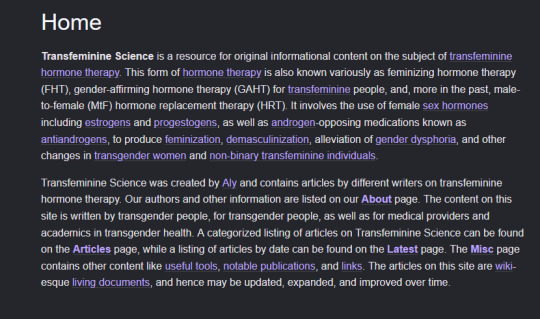

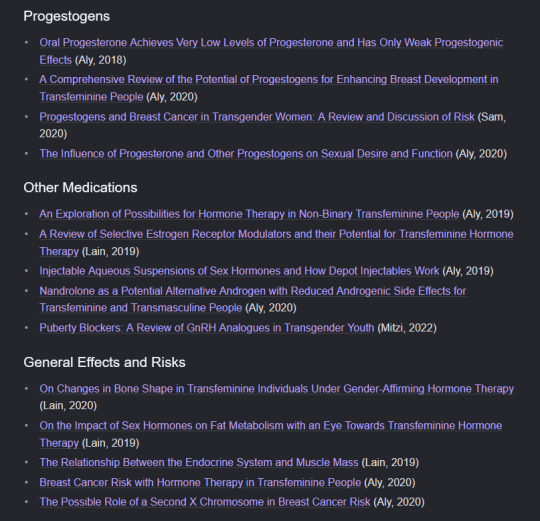
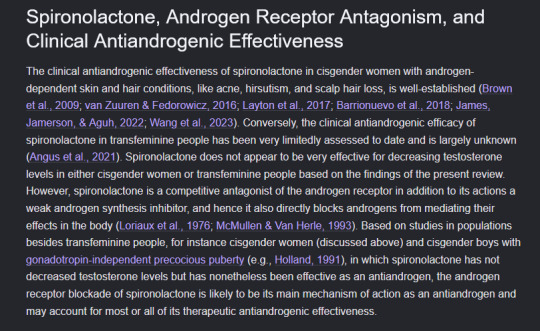

this is so much more accurate than any guide i could ever hope to create for folks, so please feel free to read the numerous articles the site has to offer, this is a very informative collection of articles and resources that you do not have to go combing through google for.
#transfem#transfemme#transfeminine#mtf#transgender#trans#non binary#nonbinary#enby#genderfluid#genderqueer#lgbtqia#lgbtq#lgbt#queer#agender#multigender#bigender#lesbian#transbian#trans lesbian#femme#femme lesbian#butch#butch lesbian#polygender#trans woman#trans women#trans girl#trans lady
3K notes
·
View notes
Text
25 Years of Exploring the Universe with NASA's Chandra Xray Observatory
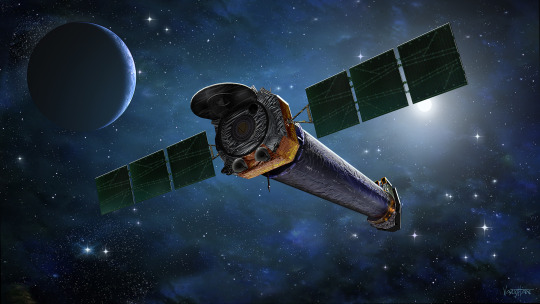
Illustration of the Chandra telescope in orbit around Earth. Credit: NASA/CXC & J. Vaughan
On July 23, 1999, the space shuttle Columbia launched into orbit carrying NASA’s Chandra X-ray Observatory. August 26 marked 25 years since Chandra released its first images.
These were the first of more than 25,000 observations Chandra has taken. This year, as NASA celebrates the 25th anniversary of this telescope and the incredible data it has provided, we’re taking a peek at some of its most memorable moments.
About the Spacecraft
The Chandra telescope system uses four specialized mirrors to observe X-ray emissions across the universe. X-rays that strike a “regular” mirror head on will be absorbed, so Chandra’s mirrors are shaped like barrels and precisely constructed. The rest of the spacecraft system provides the support structure and environment necessary for the telescope and the science instruments to work as an observatory. To provide motion to the observatory, Chandra has two different sets of thrusters. To control the temperatures of critical components, Chandra's thermal control system consists of a cooling radiator, insulators, heaters, and thermostats. Chandra's electrical power comes from its solar arrays.
Learn more about the spacecraft's components that were developed and tested at NASA’s Marshall Space Flight Center in Huntsville, Alabama. Fun fact: If the state of Colorado were as smooth as the surface of the Chandra X-ray Observatory mirrors, Pike's Peak would be less than an inch tall.

Engineers in the X-ray Calibration Facility at NASA’s Marshall Space Flight Center in Huntsville, Alabama, integrating the Chandra X-ray Observatory’s High-Resolution Camera with the mirror assembly, in this photo taken March 16, 1997. Credit: NASA
Launch
When space shuttle Columbia launched on July 23, 1999, Chandra was the heaviest and largest payload ever launched by the shuttle. Under the command of Col. Eileen Collins, Columbia lifted off the launch pad at NASA’s Kennedy Space Center in Florida. Chandra was deployed on the mission’s first day.
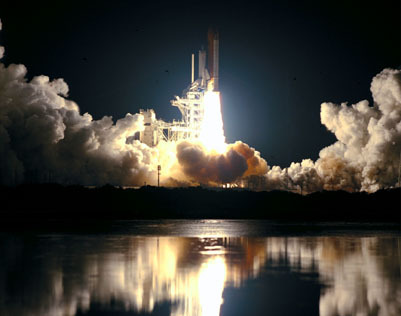
Reflected in the waters, space shuttle Columbia rockets into the night sky from Launch Pad 39-B on mission STS-93 from Kennedy Space Center. Credit: NASA
First Light Images
Just 34 days after launch, extraordinary first images from our Chandra X-ray Observatory were released. The image of supernova remnant Cassiopeia A traces the aftermath of a gigantic stellar explosion in such captivating detail that scientists can see evidence of what is likely the neutron star.
“We see the collision of the debris from the exploded star with the matter around it, we see shock waves rushing into interstellar space at millions of miles per hour,” said Harvey Tananbaum, founding Director of the Chandra X-ray Center at the Smithsonian Astrophysical Observatory.

Cassiopeia A is the remnant of a star that exploded about 300 years ago. The X-ray image shows an expanding shell of hot gas produced by the explosion colored in bright orange and yellows. Credit: NASA/CXC/SAO
A New Look at the Universe
NASA released 25 never-before-seen views to celebrate the telescopes 25th anniversary. This collection contains different types of objects in space and includes a new look at Cassiopeia A. Here the supernova remnant is seen with a quarter-century worth of Chandra observations (blue) plus recent views from NASA’s James Webb Space Telescope (grey and gold).
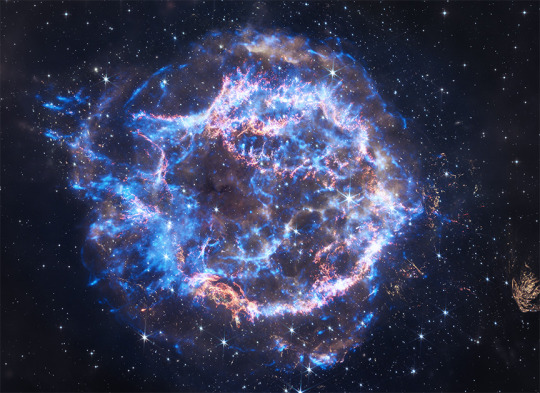
This image features deep data of the Cassiopeia A supernova, an expanding ball of matter and energy ejected from an exploding star in blues, greys and golds. The Cassiopeia A supernova remnant has been observed for over 2 million seconds since the start of Chandra’s mission in 1999 and has also recently been viewed by the James Webb Space Telescope. Credit: NASA/CXC/SAO
Can You Hear Me Now?
In 2020, experts at the Chandra X-ray Center/Smithsonian Astrophysical Observatory (SAO) and SYSTEM Sounds began the first ongoing, sustained effort at NASA to “sonify” (turn into sound) astronomical data. Data from NASA observatories such as Chandra, the Hubble Space Telescope, and the James Webb Space Telescope, has been translated into frequencies that can be heard by the human ear.
SAO Research shows that sonifications help many types of learners – especially those who are low-vision or blind -- engage with and enjoy astronomical data more.
Click to watch the “Listen to the Universe” documentary on NASA+ that explores our sonification work: Listen to the Universe | NASA+
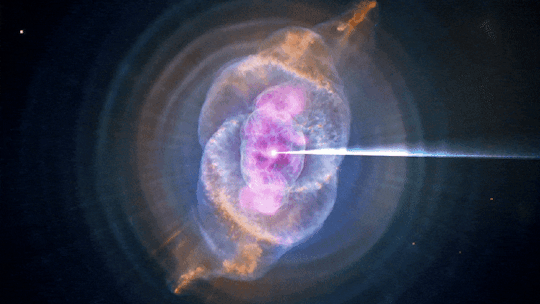
An image of the striking croissant-shaped planetary nebula called the Cat’s Eye, with data from the Chandra X-ray Observatory and Hubble Space Telescope. NASA’s Data sonification from Chandra, Hubble and/or Webb telecopes allows us to hear data of cosmic objects. Credit: NASA/CXO/SAO
Celebrate With Us!
Dedicated teams of engineers, designers, test technicians, and analysts at Marshall Space Flight Center in Huntsville, Alabama, are celebrating with partners at the Chandra X-ray Center and elsewhere outside and across the agency for the 25th anniversary of the Chandra X-ray Observatory. Their hard work keeps the spacecraft flying, enabling Chandra’s ongoing studies of black holes, supernovae, dark matter, and more.
Chandra will continue its mission to deepen our understanding of the origin and evolution of the cosmos, helping all of us explore the Universe.

The Chandra Xray Observatory, the longest cargo ever carried to space aboard the space shuttle, is shown in Columbia’s payload bay. This photo of the payload bay with its doors open was taken just before Chandra was tilted upward for release and deployed on July 23, 1999. Credit: NASA
Make sure to follow us on Tumblr for your regular dose of space: http://nasa.tumblr.com
2K notes
·
View notes
Text
"Power BI helps businesses collect, analyze, and visualize data. To boost your career, get Power BI certified. SCON Institute is a top Power BI certification training institute in Mumbai.
SCON Institute offers top-notch business analytics and data science training. A complete Power BI certification course covers data modeling, visualization, and report development. Hands-on Power BI training helps you solve real-world business problems.
SCON Institute offers Power BI certification training in Mumbai at a moderate cost. The cost of the training program depends on its length and certification level. SCON Institute offers inexpensive, high-quality training.
SCON Institute trainers have real-world Power BI experience. They understand the tool well and can offer practical advice on its use. Trainers will provide personalized advice throughout the training program.
SCON Institute offers other business analytics and data science courses than Power BI certification. This lets you learn more about this field.
SCON Institute offers affordable, high-quality Power BI certification training in Mumbai. One of the leading Power BI certification training institutions in the city, they offer thorough course content, hands-on instruction, and skilled trainers. contact-7676301459 [email protected]
powerbi #microsoft #businessintelligence #excel #dataanalytics #datascience
#"Power BI helps businesses collect#analyze#and visualize data. To boost your career#get Power BI certified. SCON Institute is a top Power BI certification training institute in Mumbai.#SCON Institute offers top-notch business analytics and data science training. A complete Power BI certification course covers data modeling#visualization#and report development. Hands-on Power BI training helps you solve real-world business problems.#SCON Institute offers Power BI certification training in Mumbai at a moderate cost. The cost of the training program depends on its length#high-quality training.#SCON Institute trainers have real-world Power BI experience. They understand the tool well and can offer practical advice on its use. Train#SCON Institute offers other business analytics and data science courses than Power BI certification. This lets you learn more about this fi#SCON Institute offers affordable#high-quality Power BI certification training in Mumbai. One of the leading Power BI certification training institutions in the city#they offer thorough course content#hands-on instruction#and skilled trainers.#contact-7676301459#[email protected]#powerbi#microsoft#businessintelligence#excel#dataanalytics#datascience
0 notes
Text
Do you have a snoot noodle or other variation of sighthound? If yes, there’s new heart health research for the breed happening!
A researcher at Texas A&M whose work I’m familiar with is starting a new study looking at genetic factors contributing to heart disease in Borzoi and related breeds. They just put out a call for dog owners who are willing to submit saliva samples & (noodle) medical records. Studies like this need a big sample size! They’re accepting new sign-ups starting now until March 1, 2025, for dogs both in the US and internationally.
Let’s help make some science!
From the study page:
“Background and purpose
Recent research in Borzoi dogs has revealed that dogs of this breed experience sudden, unexplained death. About 85% of sudden, unexplained deaths in humans are linked to an underlying heart disease. Our existing research in Borzoi dogs has shown that they are predisposed to developing arrhythmias (abnormal heart rhythms) and dilated cardiomyopathy (a heart muscle disease causing dilated heart chambers and weak pumping function).
Due to our documentation of the frequency of these conditions in Borzoi dogs, we seek to identify responsible genetic variations similar to what is seen in humans with electrical cardiac diseases that trigger arrhythmias and dilated cardiomyopathy.
The objective of our study is to identify genetic mutations associated with heart disease in Borzoi dogs and document their existence in other sighthound breeds.
What happens in this study
We are collecting saliva samples from both healthy Borzoi and Borzoi dogs affected with arrhythmias and/or dilated cardiomyopathy. We will also collect saliva samples from any other sighthound breeds.
We will extract DNA from these samples and perform genomic sequencing on a select number while retaining the remainder for further screening.By analyzing the sequencing data, we can compare the genes of healthy and affected Borzoi dogs and identify variants linked to their heart conditions. We will also compare the findings in Borzoi dogs to results from other sighthound breeds.
Pet owner responsibilities
A swab kit will be sent to you for at home use along with a link to an instructional video on how to properly obtain a swab of the mouth. The kit will contain equipment to collect the saliva swab, a history form for your pet, a client consent form and a shipping label to return samples to us.
Participation requirements
To participate, you must have a Borzoi dog or a sighthound breed that is either healthy or affected by arrhythmias and/or dilated cardiomyopathy. Pets may be any age or sex. Electronic or paper veterinary medical records will need to be provided.
Benefits and risks of participating
There is little to no risk for taking a brief swab of the mouth for saliva collection if procedures outlined in the video are followed. No individual genetic test results will be provided to study participants.
Compensation
There is no cost to the owner for participating in this study. No compensation will be provided.”
#I know this lab from big cat genetics#but they do good work on lots of things#sighthound#borzoi#silken windhound#greyhound#afghan hound#ongoing research#citizen science contributions#contribute to science
2K notes
·
View notes
Text

Stupid Girl (fondly)
not really sure what this is, but the scott rot was real after watching twisters
Word Count: 1.4k
Summary: Scotts an asshole but he secretly cares (?)
Scott was irritated, although that wasn’t saying much, considering he usually was. The heat and lack of data they’d collected due to Javi following Kate around had him more on edge than usual. It didn’t help that you had been ignoring him.
There’s no way he would ever admit to the fact, but he missed you. He knew he’d messed up earlier, and you were usually more forgiving of his moods, but the heat seemed to have you on edge too.
Thinking about it now, you’re surprised the two of you hadn’t gotten into such a fight before this, considering the difference in your jobs. Scott profited off the tornado victims, and you offered your services for free.
During the calmer seasons, you worked as a nurse in a nearby clinic, and during tornado season, you normally frequented the towns with the most wreckage and helped the victims in any way you could.
Scott and you had met in a similar way, actually. He had been in one of the town’s aftermaths to help his uncle with marketing for Storm Par when he saw you. You were treating a small scrape on a kid no older than 10. Scott had rolled his eyes when he saw the kid’s tears. It was a scrape, and here you were doting on him like it was a gash. Once the kid had run off to find his mother, Scott approached you. Once he got closer, he noted you were… pretty. Not that he cared, obviously.
“He was fine,” Scott scoffed, almost annoyed.
You had been confused at first, mumbling, “Sorry?” as you stood to brush yourself off from where you had been crouching next to the boy.
“He’s gonna complain about a paper cut if he gets coddled like that,” he smacked his gum.
“He’s a kid. Plus, paper cuts hurt,” you countered, raising your head to look at him.
And not to be dramatic, but he was gorgeous. Maybe that’s why you ignored the obvious asshole demeanor he had.
Scott rolled his eyes. “He’s a wuss,” and he fought a smile at the offended look you had at his words.
You glared at him and almost argued, but decided he wasn’t worth your time. No matter how gorgeous.
Scott, unfortunately for him, could not say the same.
“I’m Scott,” he said, even reaching out his hand. Not because he wanted to feel your hand or anything; he was doing it to be polite. At least, that’s what he told himself.
You rolled your eyes, but it was more lighthearted than anything, and told him your name, reaching out your own hand to shake his.
He was disturbed with himself for feeling so shocked at the contact. Your hand was so soft, and it made him want to pull you closer.
An intrusive thought. A vile intrusive thought that he blamed you for internally. You were trying to distract him with your pretty looks and soft hands. Well, Scott was stronger than that, so he vowed to himself he wouldn’t speak to you again.
That vow lasted about a week.
It wasn’t his fault, not really. You had been at almost every single one of the tornado aftermaths, and he had been dragged by Javi to two of them and by his uncle to one. And every single time, he found himself gravitating toward you to start a conversation.
You’d been less interested when he first approached you, wondering why you were in the town at all, especially since you weren’t getting paid.
He shut up soon after realizing how repulsed you seemed to be by the question.
By the second time, he knew to steer clear of certain topics and asked you more friendly questions, like where you grew up and why you were a nurse in the first place.
He figured out many things about you by the fourth time he’d seen you, and by the fifth, you had warmed up to him.
You learned he was smart. And not just in science and tornados. He was actually pretty well-rounded, just maybe not in social situations.
You learned he was cocky about almost everything: his education, wealth, success, and looks. Though, after having met his uncle, it made sense. The trait ran in the family, apparently.
You learned Scott was more fun than you originally thought. Maybe fun was an exaggeration, but he was certainly more.
Now, it’s been three weeks since you first met, and you’ve been ignoring him due to an impassive comment he made. How could you blame him? Nothing had been going according to plan, and Storm Par had hardly collected enough evidence since Kate and the YouTubers were in town.
So maybe telling you he found your job pointless wasn’t the smartest thing to do. What he had been trying to say was you should just stay at your clinic to help people from there. He thought it was pointless that you weren’t benefiting from helping them right at the scene.
You hadn’t liked that at all and called him an asshole right before retreating back to your medical tent that was set up.
Scott rolled his eyes, figuring you’d be over it in ten minutes, but then it became twenty, and thirty, and after an hour, Scott had to leave with Javi to follow up a storm. Hopefully getting there before Tyler and Kate.
It was all fine until Javi wanted to go follow Kate to the town the tornado was headed towards. Scott was upset. Of course, Javi wanted to go help them. It made his eye twitch; they needed the data.
He says the words of not caring about the victims before he can stop himself. He winces internally, and Javi looks at him horrified. However, Scott hadn’t planned on taking it back until,
“Your girlfriend is out there,” Javi pointed out, desperate to get through to him.
You were not his girlfriend. But Scott knew what he meant and fought the urge to hit the dashboard in frustration.
He cursed under his breath. “Well? Are you waiting for a green light? Fucking drive,” he grumbled, but the worry swelling in his chest was real.
The rest happened ten times as fast. The movie theater had been split in half, a couple dozen people taken by it, and Kate was somewhere in Tyler’s truck on a suicide mission, at least that’s what he heard later. He wasn’t there. No, after the tornado had stopped, even before it did, really, Scott was a frantic mess looking for you between the crowds.
You weren’t at the theater, nor at the gas station, and hadn’t been in any of the nearby stores. Scott’s heart sunk, and he was almost going to face the possibility that you might be dead. Almost.
As he was jogging up a block in search of you, he saw a small, crushed little shed. He was surprised the majority of it was still there, even though it had fully collapsed. That’s when he saw a hand. Not just any hand—your hand. He knew from staring at it long enough.
He rushed over in a panicky breath and called your name a few times before lifting some of the wood off you.
You groaned when you felt the weight being taken off you and felt dried blood near your temple.
“Scott?” you mumbled warily.
He let out a breath of relief. “Yeah. S’me.” Then, more firmly, “The fuck were you thinking, huh? You know better than to stay in a little shack. You’re damn lucky you didn’t get swept up.”
You smiled softly at his scolding. “I was helping a dog.” As if on cue, the puppy that was curled in your chest during the storm barked.
Scott glared, unamused. “You could’ve died,” he said bluntly, grabbing you by the arms softly, whispering apologies at your whimpers. He got you out of the destroyed shed (the dog too) and pulled you in for a hug. More for him than you. “I thought you died,” he stressed, quieter this time.
“You’d miss me,” you teased in a light voice, though the laughing made your ribs hurt.
He rolled his eyes and pressed a kiss to the top of your head, holding you closer. “Stupid girl,” but the fondness in his voice wasn’t something he could hide.
#scott miller#scott twisters#scott x reader#scott miller x reader#twisters fic#twisters scott#David Corenswet#twisters 2024#twisters movie#twisters#tyler owens#kate carter#scott miller x you#kate x tyler#twisters fanfic#twisters x reader#twisters spoilers#All photos from Pintrest
891 notes
·
View notes
Text

In 1989, a team at the Space Telescope Science Institute, led by Dr. Barry Lasker, published the Guide Star Catalog to aid in accurately pointing the telescope.
Collecting data from stars and other astronomical targets requires knowledge of their precise location in the sky, such as the stars around the Whirlpool Galaxy. Because the apparent position of a target changes as Hubble orbits, it is important to have the ability to lock onto the target during observations.
Learn more about the catalog: https://bit.ly/4lk1nHR
90 notes
·
View notes
Text
youtube
Meet the MOLA AUV, a multimodality, observing, low-cost, agile autonomous underwater vehicle that features advanced sensors for surveying marine ecosystems. 🤖🪸
At the core of the MOLA AUV is a commercially available Boxfish submersible, built to the CoMPAS Lab's specifications and enhanced with custom instruments and sensors developed by MBARI engineers. The MOLA AUV is equipped with a 4K camera to record high-resolution video of marine life and habitats. Sonar systems use acoustics to ensure the vehicle can consistently “see” 30 meters (100 feet) ahead and work in tandem with stereo cameras that take detailed imagery of the ocean floor.

Leveraging methods developed by the CoMPAS Lab, the vehicle’s six degrees of freedom enable it to move and rotate in any direction efficiently. This agility and portability set the MOLA AUV apart from other underwater vehicles and allow it to leverage software algorithms developed at MBARI to create three-dimensional photo reconstructions of seafloor environments.
In its first field test in the Maldives, the MOLA AUV successfully mapped coral reefs and collected crucial ocean data. With the MOLA AUV’s open-source technology, MBARI hopes to make ocean science more accessible than ever. Watch now to see MOLA in action.
Learn more about this remarkable robot on our website.
86 notes
·
View notes
Text
Writing Notes: Scientific Inquiry

Scientific Inquiry - a form of problem-solving and questioning that helps people come to a greater understanding of observable phenomena.
An understanding of this style of scientific reasoning forms the basis upon which the nature of science itself rests.
Once you become familiar with scientific inquiry, you can use it for specifically science-related study or as just one additional tool in your arsenal of critical thinking skills.
Core Elements of the Scientific Inquiry Process
From encouraging scientific questions to facilitating well-reasoned conclusions, the scientific inquiry process helps illuminate our understanding of the world. Here are 7 core elements to the scientific inquiry process:
Asking constant questions: At the center of both the scientific method and general scientific inquiry lies the ability to ask questions well. Make observations about a particularly interesting phenomenon and then pose questions about why such a thing happens. Let preexisting scientific theories guide your questioning, but keep in mind every theory continues to be just that—a theory—until scientific inquiry definitively proves or disproves it.
Testing your inferences: Scientific progress hinges on your ability to experiment and test inferences about evidence. To do so, you need to set up an independent variable (something you will use to test) and a dependent variable (the thing or things you are testing). Seeing how well your inferences or predictions match up with the reality of a given experiment is essential to scientific inquiry.
Making connections: As you make observations about a specific phenomenon, make connections with every other relevant topic you can remember from your past science lessons or research. Scientific knowledge is as much a result of old realizations as it is of new discoveries.
Seeking evidence: As you seek to understand the natural world, there’s no substitute for hard evidence. Collect data and gather evidence relentlessly throughout your scientific investigations. The more evidence you have to answer your initial questions, the more ironclad your ultimate case will be when you draw conclusions.
Classifying data correctly: Science is as much a process of data collection and classification as it is of asking and answering questions. This means knowing how to elucidate or graph out your discoveries in a way other people can understand. It also means using citations from other scientific journals and texts to bolster your ultimate argument as to why a particular phenomenon occurs.
Drawing conclusions: Eventually, you need to draw conclusions from the data you collect. After you’ve made an exhaustive study of your specific focus, use inductive reasoning to make sense of all the new evidence you’ve gathered. Scientific ideas are always malleable and never completely concrete—alternative explanations are always possible, and new evidence should lead to new questions and conclusions.
Sharing findings: Science is an innately group-centered discipline. The more people interpret data, the better chance there is to ensure there are no loopholes in new research. No one person’s understanding of science content is infinite, so it’s important to let other qualified people ask questions of your conclusions. Natural science is more of a never-ending collaborative process than one with a concrete point of termination.
Teaching science means ensuring learners understand how to conduct qualitative and inquiry-based learning.
Science teachers must utilize a pedagogy that foregrounds hypothesizing, experimenting, and drawing on other scientific knowledge in both theoretical and practical ways.
Educational research indicates that it can help students see the correlation between scientific inquiry and everyday life, whether in elementary school or high school.
This sort of analogization helps people understand that a scientific frame of thinking is quite intuitive when you observe it within more commonplace parameters.
As a simplistic example, imagine a student has a hard time understanding the effect of heat as an abstract force.
Allowing them to observe the degree to which bread burns at different temperatures in a toaster would help make the point clear in a more hands-on way.
Source ⚜ More: Notes & References ⚜ Writing Resources PDFs
#scientific inquiry#research#studyblr#writeblr#dark academia#writing reference#science#writers on tumblr#spilled ink#writing prompt#creative writing#writing inspiration#writing ideas#writing notes#light academia#writing resources
71 notes
·
View notes
Note
I keep imagining some robotnik superior showing up unexpectedly in his lab and being like "🤨...Wait there are three mermai... *stone kills him*
I plan on writing a fic about this eventually, but I've been short on time lately 😭 Long story short, Robotnik moves Stone to an underwater lab he's been building to save him from being un-alived by the government, and at roughly the same time they find out Stone is pregnant. So fortunately the merfamily is totally safe! Here's a blurb from the WIP of that fic, since it probably won't be posted for a while:
---
The words echo off the lifeless conference room walls and rattle around unpleasantly in Robotnik’s brain. They are not words Robotnik wants to hear, and if he’s being honest, some time ago he’d forgotten that he’d ever have to hear them in the first place.
“Doctor?” Commander Walters offers Robotnik an appropriately concerned frown. “Did you hear me?”
Robotnik clears his throat, refocusing. “No, uh- no. I must have spaced out. Say that one more time for me.” He heard him loud and clear, of course, but he wants to pick through it one more time, see if there are any loopholes or contradictions he can take advantage of to be found in the words.
“Oh, sure… I understand, I’m sure you’ve been working around the clock lately.” Commander Walters says. “I said that if you’ve acquired all the data you can from the living specimen, it’s time to turn him over to the autopsy team. It’s still your project of course, so you can be as involved as you’d like to be going forward. But after six months of research, I think it’s safe to say we can–” here, Walters does that annoying rotating motion with both of his pointer fingers, “--wrap it up.”
Robotnik feels a little bit sick. Furious, mostly, but the sour heaviness in his guts is close to making him gag. Has it been six months already? Back then, this plan didn’t bother Robotnik in the slightest. When he first stormed into the biology lab to assert himself as the project leader, he didn’t care how injured and malnourished Stone was - Stone wasn’t Stone back then, he was the ‘specimen’. Robotnik hadn’t chewed out the pitiful scientists over their subpar treatment of Stone because he’d worried about Stone’s safety, it was because they’d compromised the scientific process. There was no sense in researching a living subject if that subject was too weak and sick to move, after all.
Obviously Robotnik’s opinion had changed rather quickly. He’d been told that the ‘merman’ wasn’t intelligent, wasn’t sentient. That he was mindless and violent. Fools. Almost as soon as Robotnik dismissed the rest of the team, it became apparent none of that was true. Stone quickly proved himself to be highly intelligent, learning ASL almost as fast as Robotnik once had. He was complex, loyal, and terribly interesting. He saw the world so differently than anyone Robotnik had ever met.
This is a very wordy way of saying that Robotnik fell in love, even if he hated framing it in such a simplistic, childish way.
Stone fell first, to be fair. He’d marked Robotnik, he claimed him, they were mates and now Robotnik is hearing another person say that Stone needs to be killed and torn open soon. It all seems so surreal.
“You can’t just put a time limit on science, Commander,” Robotnik says icily. “Six months is nothing. I haven’t even had ample time to study his metabolic rate yet, it’s vastly different from a humans–” “Six months was your estimation, not mine,” Walters counters. “When you took over the project, that was your projected timeframe.”
Robotnik inwardly kicks himself. He originally gave himself six months to ensure he had a comfortable cushion of time, but he’d been positive four months is all it would take to collect all the necessary data before passing Stone off to another team.
“Well if it hadn’t taken two months for the creature to fully recover from what those amateurs did to it before I arrived, I would have been done by now!” Robotnik growls. It hadn’t taken two months for Stone to recover, but it seemed a believable amount of time to a person who isn’t personally familiar with how quickly merpeople heal. “Why do you think I’ve been ‘working around the clock’, Commander? Making up for lost time!”
Walters frowns in consideration, rubbing a knuckle thoughtfully against his stubbly chin. “Ah yes, I remember reading about that in your initial reports. I hadn’t considered how much that may have set you back. In that case, I’ll give you another two months to finish your research, Doctor. Does that sound fair?”
It takes Robotnik less than a second to run the numbers, the estimations and impromptu simulations - yes, he could certainly finish his work in two months. Not the work Walters was expecting him to finish, obviously. Something much, much more important. “Two months sounds more than fair, Commander.”
113 notes
·
View notes
Text
things that remind me of the nerdy prudes
(because like two people reblogged this one i did forever ago for the losers and i forgot how fun these are)
grace:
getting veggie tales songs stuck in your head as an adult, knee socks, eating all your broccoli, sparkly butterfly clips, watching sunlight glint off a lake through the treeline, guinea pigs, friendship bracelets off a water bottle, being secretly glad when someone you don’t like turns out to be a bad person, a bunch of cellophane candy wrappers crinkling at the bottom of your purse, being a little too into archery at summer camp, pastel bible highlighters, banana pancakes, tying way too many ribbons around the advent wreath, leggings under dresses, daydreaming about how you’d escape if you ever got kidnapped, strawberry ice cream, roller skating with almost too much protective gear on, cloud gazing, obvious family secrets that everyone refuses to tell you, feeling weirdly guilty for ordering your steak rare, bringing too many swaps to girl scout camp so you can trade with everyone, asking a new friend for their email address, long denim skirts
steph:
really dry liquid lipstick you bought in your freshman year of high school but refuse to throw out, 24 hour diners, typing in all lowercase but never actually changing the setting in your phone, listening to music you hate but gaslighting yourself until you enjoy it, really dark purple nail polish that looks black, collecting crystals even though you don’t really believe in them, saying your team bella (but secretly being team jacob), getting mad your vape was confiscated at your high school graduation, one million rings, coffee ice cream, tinfoil in a microwave, exclusively wearing sports bras, shoplifting, pink monster, thinking cigarettes are really hot, never wearing a jacket even if your cold, penny boarding, drinking four loko, regretting four loko, refusing to put your hair up even when you really should, kuromi, half fallen down led lights, playing your mom’s old guitar, sour skittles
pete:
planetariums, being overly competitive at board games, ginger ale, using a chapstick until it runs out, really liking marshmallows, really liking hot chocolate, hating marshmallows in your hot chocolate, buying a bunch of cool notebooks and never using them, forever dm, pretending you didn’t find asdf movies as funny as you actually did, m&ms, freezing cold hands, hand-me-down sweaters, only ordering chicken fingers and french fries, being intrinsically trusted by cats, carrying a clarinet to school every day, skipping episodes of next gen if they don’t feature data, praying on the first day of school that your teachers didn’t have your older sibling, transition glasses lenses (that you absolutely regret), dry krave cereal, secretly finding most museums really boring, grow-your-own-geode science kits, wing tip tap shoes, messenger bags, only doing extracurriculars that look good on college applications
ruth:
your comfort gay newsies fanfiction from middle school, being jealous of your younger sibling, those phone cases with glitter and charms floating in water, team edward and team jacob, wishing you hadn’t quit dance, buying fun jewelry and never wearing it, being devastated your hair is too dark to dip dye in kool aid, sticky lip gloss, painting every nail a different color, self sabotage, crushed velvet scrunchies, the grease soundtrack, wanting to be a rockette when you grew up, never learning how to do make up, begging to do figure skating as a kid, begging to do beauty pageants as a kid, begging to do cheerleading as a kid, turquoise braces bands, sinclair gas stations, showing up to an audition that you didn’t realize had a dance call, dunkin’ donuts munchkins, squirrel girl comic books, one half of a best friend necklace you wore longer than you should have
richie:
trying to get the marble out of a ramune bottle, wearing big headphones 24/7 (even if they aren’t playing anything), staining your best friend’s bathtub blue with hair dye, sour patch kids, enamel pins, discord calls across like three different time zones, the charlie bone book series, getting in trouble for drawing in class, being the friend with a car but also being a terrible driver, a pokémon card binder, that one kid who was really, really good at cup stacking, wearing shorts in the middle of winter, thirty-nine minute long voice memos, being exceptional at claw machines, vocaloid songs, your pet parakeet hanging out on top of your head, that one vaguely traumatizing round of the pocky game from seventh grade, regularly broken duolingo streaks, getting in trouble for bringing a real katana to your freshman year halloween dance
#npmd#starkid#nerdy prudes must die#grace chasity#Stephanie lauter#peter spankoffski#ruth fleming#richie lipschitz#this is pretty much just for me because these are such unreadable blocks of text#but I think they’re FUN#and also I’m really trying to remember how to write these guys#hatchetfield
63 notes
·
View notes
Note
How much/quickly do you think AI is going to expand and improve materials science? It feels like a scientific field which is already benefiting tremendously.
My initial instinct was yes, MSE is already benefiting tremendously as you said. At least in terms of the fundamental science and research, AI is huge in materials science. So how quickly? I'd say it's already doing so, and it's only going to move quicker from here. But I'm coming at this from the perspective of a metallurgist who works in/around academia at the moment, with the bias that probably more than half of my research group does computational work. So let's take a step back.
So, first, AI. It's... not a great term. So here's what I, specifically, am referring to when I talk about AI in materials science:
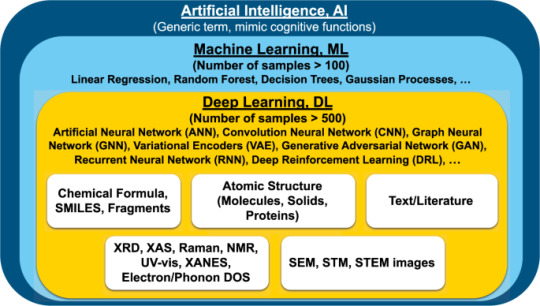
Most of the people I know in AI would refer to what they do as machine learning or deep learning, so machine learning tends to be what I use as a preferred term. And as you can see from the above image, it can do a lot. The thing is, on a fundamental level, materials science is all about how our 118 elements (~90, if you want to ignore everything past uranium and a few others that aren't practical to use) interact. That's a lot of combinations. (Yes, yes, we're not getting into the distinction between materials science, chemistry, and physics right now.) If you're trying to make a new alloy that has X properties and Y price, computers are so much better at running through all the options than a human would be. Or if you have 100 images you want to analyze to get grain size—we're getting to the point where computers can do it faster. (The question is, can they do it better? And this question can get complicated fast. What is better? What is the size of the grain? We're not going to get into 'ground truth' debates here though.) Plenty of other examples exist.
Even beyond the science of it all, machine learning can help collect knowledge in one place. That's what the text/literature bubble above means: there are so many old articles that don't have data attached to them, and I know people personally who are working on the problem of training systems to pull data from pdfs (mainly tables and graphs) so that that information can be collated.
I won't ramble too long about the usage of machine learning in MSE because that could get long quickly, and the two sources I'm linking here cover that far better than I could. But I'll give you this plot from research in 2019 (so already 6 years out of date!) about the growth of machine learning in materials science:

I will leave everyone with the caveat though, that when I say machine learning is huge in MSE, I am, as I said in the beginning, referring to fundamental research in the field. From my perspective, in terms of commercial applications we've still got a ways to go before we trust computers to churn out parts for us. Machine learning can tell researchers the five best element combinations to make a new high entropy alloy—but no company is going to commit to making that product until the predictions of the computer (properties, best processing routes, etc.) have been physically demonstrated with actual parts and tested in traditional ways.
Certain computational materials science techniques, like finite element analysis (which is not AI, though might incorporate it in the future) are trusted by industry, but machine learning techniques are not there yet, and still have a ways to go, as far as I'm aware.
So as for how much? Fundamental research for now only. New materials and high-throughput materials testing/characterization. But I do think, at some point, maybe ten years, maybe twenty years down the line, we'll start to see parts made whose processing was entirely informed by machine learning, possibly with feedback and feedforward control so that the finished parts don't need to be tested to know how they'll perform (see: Digital twins (Wikipedia) (Phys.org) (2022 article)). At that point, it's not a matter of whether the technology will be ready for it, it'll be a matter of how much we want to trust the technology. I don't think we'll do away with physical testing anytime soon.
But hey, that's just one perspective. If anyone's got any thoughts about AI in materials science, please, share them!
Source of image 1, 2022 article.
Source of image 2, 2019 article.
#Materials Science#Science#Artificial Intelligence#Replies#Computational materials science#Machine learning
22 notes
·
View notes
Text
KOSA Update
Following up on a previous post about the KOSA bill - a bill that would drastically change how the internet functions, in some ways enforcing the collection of private information and restricting access to educational material based on anyone’s belief that it might be harmful to children.
As of March 2024, the bill has gone through revision to reduce the ability to target marginalized communities. However, the language used in the bill is still broad and would be ultimately harmful to children and adult internet users.
Press releases like that of the American Civil Liberties Union invoke the First Amendment to highlight both the bill’s continued call for requiring or incentivizing age verification and its goal of censoring many different topics of conversation in online spaces.
If the U.S. government seeks to control, censor, and otherwise interfere with the world of the internet, then it would have to be a government program akin to public education or certain libraries. Let that government take over the responsibilities of running and funding the internet in that case if they want that power. Otherwise, the internet does not fall under federal jurisdiction.
In response to reaching out regarding this bill, one Congressman wrote that platforms like TikTok have come under scrutiny for “leaving users’ data vulnerable to access by the Chinese Communist Party, by collecting personal information on children in violation of federal law”. This Congressman does not state in this response whether he supports the KOSA bill in particular, but we hope that he is aware that this proposed bill would, by federal law, necessitate the collection of personal information of minors if websites are to follow its requirements. Additionally, TikTok’s data collection is comparable to that of other sites such as Instagram and Facebook, which are just as able to be infiltrated by political enemies of the U.S.
This update is not about the U.S. government’s ultimatum to the company ByteDance that will likely end in a U.S. ban on TikTok. Still, that news is relevant to internet users, especially those who value choice and self-determination.
In the aforementioned Congressman’s response, he also mentions the Privacy Enhancing Technology Research Act (H.R. 4755). That bill, passed in 2023, calls for organizations like the National Science Foundation to conduct and support research into technologies for mitigating privacy risks. Bills like this one are far more conducive to achieving online safety than the proposed KOSA bill. It seeks to enhance our understanding of data handling and online privacy, while the KOSA bill is more so blindly punching towards a problem that we do not yet have a clear view of.
As before, resources to further learn about and speak out against the bill are below.
Resources:
1.https://www.aclu.org/press-releases/revised-kids-online-safety-act-is-an-improvement-but-congress-must-still-address-first-amendment-concerns
2.https://www.eff.org/deeplinks/2024/02/dont-fall-latest-changes-dangerous-kids-online-safety-act
3. https://www.stopkosa.com/
4. Privacy Enhancing Technology Research Act
5. KOSA Bill Post-Revision6.https://www.eff.org/deeplinks/2024/03/analyzing-kosas-constitutional-problems-depth#
#kosa bill#stop kosa#kosa#politics#us politics#article#news#resources#first amendment#freedom of speech
90 notes
·
View notes
Text
NASA Inspires Your Crafty Creations for World Embroidery Day
It’s amazing what you can do with a little needle and thread! For #WorldEmbroideryDay, we asked what NASA imagery inspired you. You responded with a variety of embroidered creations, highlighting our different areas of study.
Here’s what we found:
Webb’s Carina Nebula
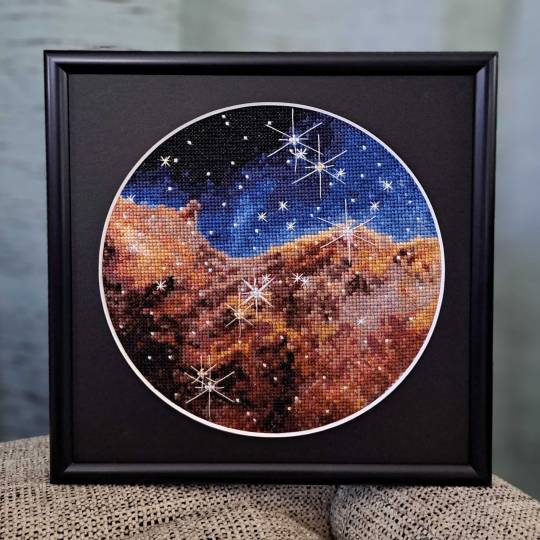
Wendy Edwards, a project coordinator with Earth Science Data Systems at NASA, created this embroidered piece inspired by Webb’s Carina Nebula image. Captured in infrared light, this image revealed for the first time previously invisible areas of star birth. Credit: Wendy Edwards, NASA. Pattern credit: Clare Bray, Climbing Goat Designs
Wendy Edwards, a project coordinator with Earth Science Data Systems at NASA, first learned cross stitch in middle school where she had to pick rotating electives and cross stitch/embroidery was one of the options. “When I look up to the stars and think about how incredibly, incomprehensibly big it is out there in the universe, I’m reminded that the universe isn’t ‘out there’ at all. We’re in it,” she said. Her latest piece focused on Webb’s image release of the Carina Nebula. The image showcased the telescope’s ability to peer through cosmic dust, shedding new light on how stars form.
Ocean Color Imagery: Exploring the North Caspian Sea
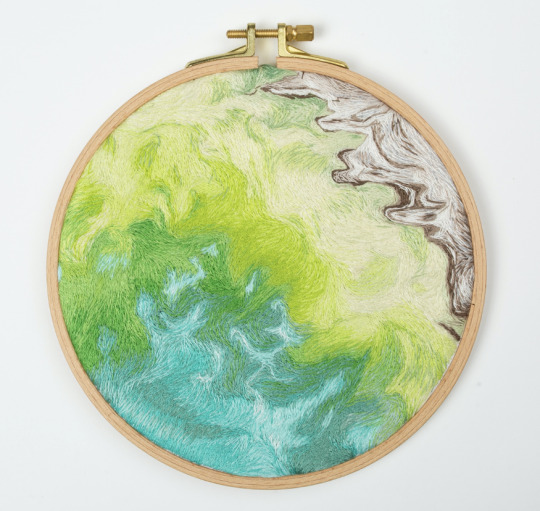
Danielle Currie of Satellite Stitches created a piece inspired by the Caspian Sea, taken by NASA’s ocean color satellites. Credit: Danielle Currie/Satellite Stitches
Danielle Currie is an environmental professional who resides in New Brunswick, Canada. She began embroidering at the beginning of the Covid-19 pandemic as a hobby to take her mind off the stress of the unknown. Danielle’s piece is titled “46.69, 50.43,” named after the coordinates of the area of the northern Caspian Sea captured by LandSat8 in 2019.
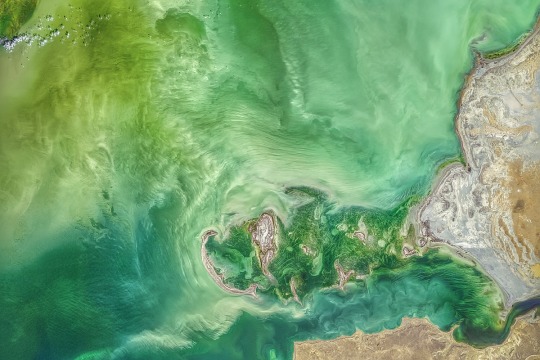
An image of the Caspian Sea captured by Landsat 8 in 2019. Credit: NASA
Two Hubble Images of the Pillars of Creation, 1995 and 2015
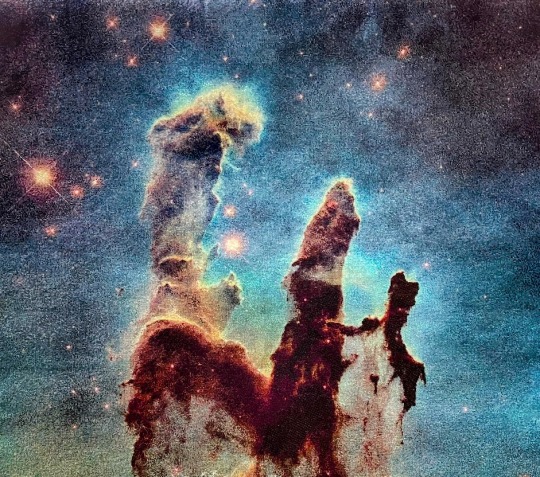
Melissa Cole of Star Stuff Stitching created an embroidery piece based on the Hubble image Pillars of Creation released in 1995. Credit: Melissa Cole, Star Stuff Stitching
Melissa Cole is an award-winning fiber artist from Philadelphia, PA, USA, inspired by the beauty and vastness of the universe. They began creating their own cross stitch patterns at 14, while living with their grandparents in rural Michigan, using colored pencils and graph paper. The Pillars of Creation (Eagle Nebula, M16), released by the Hubble Telescope in 1995 when Melissa was just 11 years old, captured the imagination of a young person in a rural, religious setting, with limited access to science education.
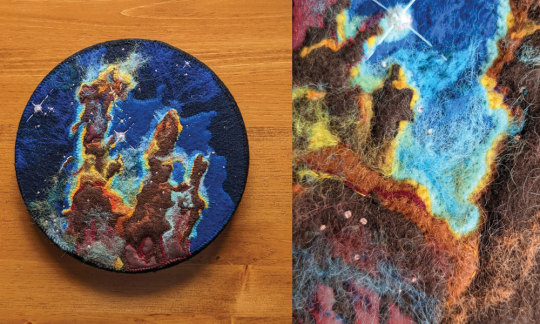
Lauren Wright Vartanian of the shop Neurons and Nebulas created this piece inspired by the Hubble Space Telescope’s 2015 25th anniversary re-capture of the Pillars of Creation. Credit: Lauren Wright Vartanian, Neurons and Nebulas
Lauren Wright Vartanian of Guelph, Ontario Canada considers herself a huge space nerd. She’s a multidisciplinary artist who took up hand sewing after the birth of her daughter. She’s currently working on the illustrations for a science themed alphabet book, made entirely out of textile art. It is being published by Firefly Books and comes out in the fall of 2024. Lauren said she was enamored by the original Pillars image released by Hubble in 1995. When Hubble released a higher resolution capture in 2015, she fell in love even further! This is her tribute to those well-known images.
James Webb Telescope Captures Pillars of Creation
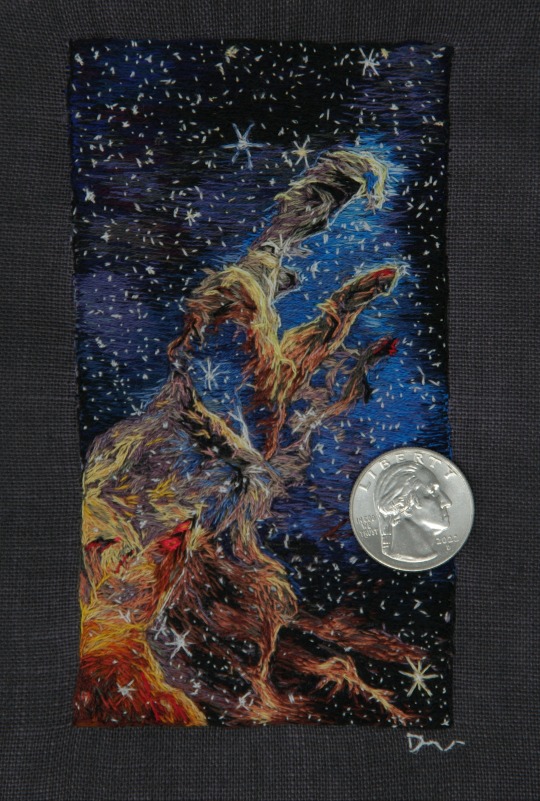
Darci Lenker of Darci Lenker Art, created a rectangular version of Webb’s Pillars of Creation. Credit: Darci Lenker of Darci Lenker Art
Darci Lenker of Norman, Oklahoma started embroidery in college more than 20 years ago, but mainly only used it as an embellishment for her other fiber works. In 2015, she started a daily embroidery project where she planned to do one one-inch circle of embroidery every day for a year. She did a collection of miniature thread painted galaxies and nebulas for Science Museum Oklahoma in 2019. Lenker said she had previously embroidered the Hubble Telescope’s image of Pillars of Creation and was excited to see the new Webb Telescope image of the same thing. Lenker could not wait to stitch the same piece with bolder, more vivid colors.
Milky Way
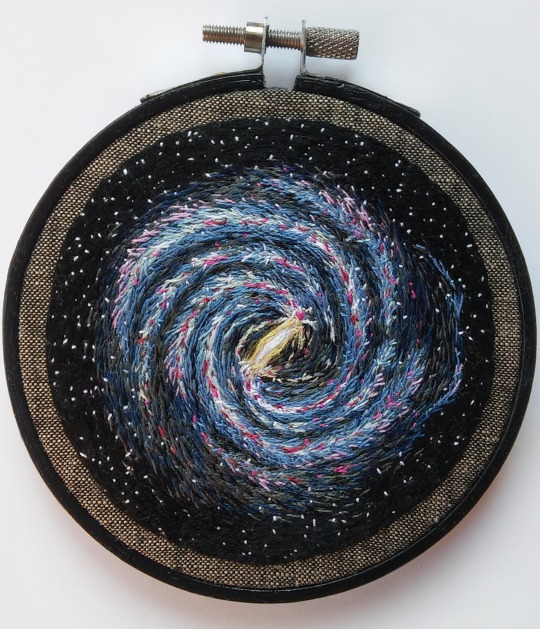
Darci Lenker of Darci Lenker Art was inspired by NASA’s imaging of the Milky Way Galaxy. Credit: Darci Lenker
In this piece, Lenker became inspired by the Milky Way Galaxy, which is organized into spiral arms of giant stars that illuminate interstellar gas and dust. The Sun is in a finger called the Orion Spur.
The Cosmic Microwave Background
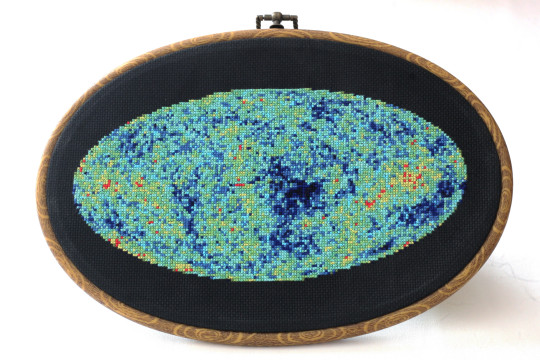
This image shows an embroidery design based on the cosmic microwave background, created by Jessica Campbell, who runs Astrostitches. Inside a tan wooden frame, a colorful oval is stitched onto a black background in shades of blue, green, yellow, and a little bit of red. Credit: Jessica Campbell/ Astrostitches
Jessica Campbell obtained her PhD in astrophysics from the University of Toronto studying interstellar dust and magnetic fields in the Milky Way Galaxy. Jessica promptly taught herself how to cross-stitch in March 2020 and has since enjoyed turning astronomical observations into realistic cross-stitches. Her piece was inspired by the cosmic microwave background, which displays the oldest light in the universe.

The full-sky image of the temperature fluctuations (shown as color differences) in the cosmic microwave background, made from nine years of WMAP observations. These are the seeds of galaxies, from a time when the universe was under 400,000 years old. Credit: NASA/WMAP Science Team
GISSTEMP: NASA’s Yearly Temperature Release
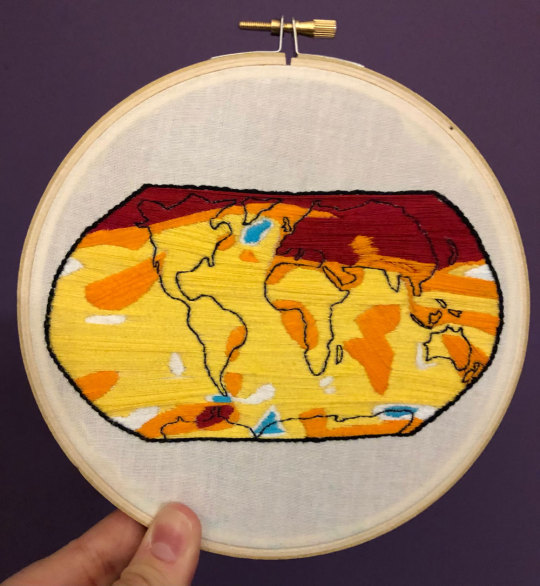
Katy Mersmann, a NASA social media specialist, created this embroidered piece based on NASA’s Goddard Institute for Space Studies (GISS) global annual temperature record. Earth’s average surface temperature in 2020 tied with 2016 as the warmest year on record. Credit: Katy Mersmann, NASA
Katy Mersmann is a social media specialist at NASA’s Goddard Space Flight Center in Greenbelt, Md. She started embroidering when she was in graduate school. Many of her pieces are inspired by her work as a communicator. With climate data in particular, she was inspired by the researchers who are doing the work to understand how the planet is changing. The GISTEMP piece above is based on a data visualization of 2020 global temperature anomalies, still currently tied for the warmest year on record.
In addition to embroidery, NASA continues to inspire art in all forms. Check out other creative takes with Landsat Crafts and the James Webb Space telescope public art gallery.
Make sure to follow us on Tumblr for your regular dose of space!
#NASA#creativity#fiber art#embroidery#art#art challenge#needlework#crafts#handmade#textile art#cross stitch#stitching#inspiration#inspo#Earth#Earth science#Hubble#James Webb Space Telescope#climate change#water#nebula#stars
6K notes
·
View notes
Text
Yan!Time Traveller

Yandere Time Traveler, who met you both in your 30s, was a scientist, and you worked at a small restaurant only a few minutes away from your workplace. He went to the place daily and was one of the most memorable customers. You even remembered his order: hot tea with four sugar packets, a breakfast burrito, and home fries.
Yandere Time Traveler made sure to buy you your own breakfast meal daily and learn more about your home life, your spouse and children, your friends and family, and anything you'd talk about. He started having feelings for you, continuously falling deeper in the two years you worked at the restaurant before coming in and being told that you quit, saddening him.
Yandere Time Traveler was soon after fired from his job, leaving him alone and bored at home. Deciding to do something with his now miserable life, he made a time machine out of scrap metal and broken tries at robots from before. He tested and tested until he made a tiny watch capable of traveling through time whenever and wherever he wanted to. He sat and tried to figure out what to do next but then realized exactly what he wanted to do. He remembered you and wondered what it would have been like if he just had a single chance with you.
Yandere Time Traveler first decided to relive the time with you, continuing to be more confident with you and pushing you to the point where you cheated on your husband with him, being the perfect man for you and living with you for two years before you were hit by a drunk driver and killed. He mourned before remembering he could redo what he'd done.
Yandere Time Traveler went back in time and killed your husband, who was only a few months old when he was suffocated and found without a pulse. Then he met you in college, and you both hit it off right away, getting closer and closer to each other until you both started dating. It took only three years after both of your graduations for him to propose to you and only a few more months until you both got married. He went back to pursue his career in science while you stayed as a house spouse, and he quickly went up in the ranks in his job, getting promoted very quickly.
Yandere Time Traveler went and founded a new company, selling the machines of the future: smart houses, sentient AI, working robotic limbs, and downloading your data into a system so that once you die, you live on in an augmented reality. However, he came up to you with a new one, asking you to test it. He said it was an ointment that quickly got rid of any acne and blemishes and told you to use it whenever needed. You and he both used it, and as your friends dropped like flies, and as you got older, you realized you weren't getting any more frail and old than you were when you started the cream. Neither had your husband.
Yandere Time Traveler decided to move both of you to a more secluded area as the world continued to advance, and he rapidly got more famous. You didn't understand why, but he said he wanted to protect you. He let you decorate as you wanted in the new house and gave you many things to do. Loving upon you and taking care of you whenever he could, his hands always finding their way into your hair when you both cuddled, and he didn't deny almost any of your requests. The only request denied was for you to leave your plot of land, at first you wished he'd let you explore and use the money he collected, though you started not caring. You loved it.
#WhiteBall#x fem!reader#x female reader#x male reader#x male y/n#yandere x you#x masc reader#x gn reader#male reader#x male#male yandere#yandere male#yandere x reader#x you#x oc#x reader#x you fluff#yandere blog#yandere#tw yandere#soft yandere#yandere aesthetic#yancore#x female y/n#female yandere#fem reader#x m reader#x f reader#x ftm reader#x mtf reader
201 notes
·
View notes
Text
Superlinguo 2024 in review
I returned to full time work after a year of parental leave. That, alone, would have been enough for this year. Unfortunately, it turned into a terrible year at my university, with key senior colleagues in my department losing their jobs.
I like these reviews most year, but looking back on last year it feels even more important than usual to remember that there were some good things that happened in spite of everything going on with my university.
Lingthusiasm in 2024
Lingthusiasm turned 8! We maintained our regular pace, posting a dozen main episodes as well as our monthly bonus episodes for patrons. We plotted our vowels and covered a wide range of topics, including some great interviews with guests.
We launched our perfectly calibrated, Very Serious ‘Which Lingthusiasm episode are you?’ quiz guide you!
We were also reviewed in the New York Times, were featured in Lauren Passell’s Podcast the Newsletter, and conducted our final survey in the trilogy we planned.
We released a new sticker/badge that says "Ask Me About Linguistics", new merch that says "more people have read the text on this shirt than I have" and a range of merch with a very elegant Gavagai from Lucy Maddox, which are both available alongside merch for all kinds of linguists and language fans.
Main episodes
A politeness episode, if you please (transcript)
Helping computers decode sentences - Interview with Emily M. Bender (transcript)
OooOooh~~ our possession episode oOooOOoohh 👻 (transcript)
Welcome back aboard the metaphor train! (transcript)
Lo! An undetached collection of meaning-parts! (transcript)
The perfectly imperfect aspect episode (transcript)
How nonbinary and binary people talk - Interview with Jacq Jones (transcript)
Brunch, gonna, and fozzle - The smooshing episode (transcript)
Scoping out the scope of scope (transcript)
What visualizing our vowels tells us about who we are (transcript)
Connecting with oral culture (transcript)
No such thing as the oldest language (transcript)
Bonus episodes
Crochet vocal tract, grammar is a team sport, gifs, and soy sauce - Deleted scenes from Jacq Jones, Emily M. Bender, and Tom Scott team interviews
Metaphors be with you! Lingthusiasm x Let’s Learn Everything crossover episode
Linguistic Travel - Estonia, Mundolingua, and Martha’s Vineyard
Xenolinguistics 👽
Behind the Scenes on the Tom Scott Language Files
Don’t you love to do a “do” episode?
The best and worst comparatives episode
Linguistic mixups - spoonerisms, mondegreens, and eggcorns
Secret codes and the joy of cryptic word puzzles
Inner voice, mental pictures, and other shapes for thoughts
How we made vowel plots with Bethany Gardner
Are thumbs fingers and which episode of Lingthusiasm are you? Survey results and a new personality quiz
Themself, Basque ergativity cartoons, and bad swearing ideas - Deleted scenes from Kirby Conrod, Itxaso Rodriguez-Ordoñez, and Jo Walton and Ada Palmer
Top Superlinguo posts in 2024
I honestly expected to have nothing to post here, so it's lovely to know that I do still get small changes to blog throughout the year.
General posts
Research Data Management. Or, How I made multiple backups and still almost lost my honours thesis.
Thinking With Your Hands, Susan Goldin-Meadow (Review)
How to Talk Language Science with Everybody, Laura Wagner & Cecile McKee (Review)
Himalayan Linguistics turns 20: Celebrating two decades of Diamond Open Access publish
Himalayan Linguistics, Linguistics Vanguard and the Australian Journal of Linguistics - my three journal editorial hats
2024 LingComm Grants – Small Grants for Communicating Linguistics to Wider Audiences
2024 LingComm Grantees: New linguistics projects for you to follow
New gesture Emoji in Unicode 15.1: Head Shaking Horizontally and Head Shaking Vertically (aka shake and nod!), and (finally) right facing emoji
Academic articles in 2024
Four publications this year, across lingcomm, gesture and emoji. I also spent a lot of this year finishing Gesture: A Slim Guide, which will be out with OUP in 2025.
McCulloch, G. & L. Gawne. 2024. Towards a theory of linguistic curiosity: applying linguistic frameworks to lingcomm and scicomm. Linguistics Vanguard 10(s3): 181-189. DOI: 10.1515/lingvan-2024-0073 [OA published version][blog summary]
Gawne, L., & Cooperrider, K. (2024). Emblems: Meaning at the interface of language and gesture. Glossa: a journal of general linguistics. doi: 10.16995/glossa.9705 [OA published version][blog summary]
Cabraal, A. & L. Gawne. 2024. Using emoji as a creative tool for data analysis. In H. Kara, D. Mannay & A. Roy (Eds), The Handbook of Creative Data Analysis, 201-212. Bristol: Polity Press.
Gawne, L., G. McCulloch, N. Sweeney, R. Alatalo, H. Bodenhausen, C. Riley & J. Grieser. 2024. Creating Inclusive Linguistics Communication: Crash Course Linguistics. In A. Charity Hudley, C. Mallinson, and M. Bucholtz (Eds), Inclusion in Linguistics, 383-396. Oxford University Press. [Open Access PDF][blog post summary]
The year ahead
After a year of upheaval, next year will be a time of rebuilding. There will be a new team, a new curriculum, and I'm not silly enough to assume that also means a new, manageable pace of work. I'll still be sharing work here and recording Lingthusiasm. I've also been spending more time on Bluesky, perhaps I'll see you there?
Browsing old Superlinguo content?
I have a welcome page on the blog that points you to aggregate posts, and series of posts I've done over the years, as well as themed collections of posts that have appeared on the blog in the last twelve years.
Previous years
Superlinguo 2023 in review
Superlinguo 2022 in review
Superlinguo 2021 in review
Superlinguo 2020 in review
Superlinguo 2020 (2019 in review)
Superlinguo 2019 (2018 in review)
Superlinguo 2018 (2017 in review)
Superlinguo 2017 (2016 in review)
Superlinguo 2015 highlights
22 notes
·
View notes